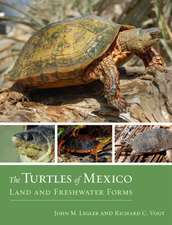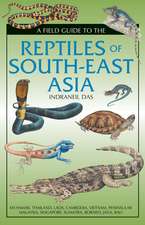Lizard Ecology
Editat de Stephen M. Reilly, Lance B. McBrayer, Donald B. Milesen Limba Engleză Paperback – 12 sep 2012
Preț: 433.31 lei
Preț vechi: 486.86 lei
-11% Nou
Puncte Express: 650
Preț estimativ în valută:
82.91€ • 86.80$ • 68.61£
82.91€ • 86.80$ • 68.61£
Carte tipărită la comandă
Livrare economică 05-19 aprilie
Preluare comenzi: 021 569.72.76
Specificații
ISBN-13: 9781107407480
ISBN-10: 1107407486
Pagini: 546
Dimensiuni: 170 x 244 x 28 mm
Greutate: 0.86 kg
Editura: Cambridge University Press
Colecția Cambridge University Press
Locul publicării:New York, United States
ISBN-10: 1107407486
Pagini: 546
Dimensiuni: 170 x 244 x 28 mm
Greutate: 0.86 kg
Editura: Cambridge University Press
Colecția Cambridge University Press
Locul publicării:New York, United States
Cuprins
Preface Stephen M. Reilly, Lance D. McBrayer, and Donald B. Miles; Historical introduction: on widely foraging for Kalahari lizards Raymond B. Huey and Eric R. Pianka; Part I. Organismal Patterns of Variation with Foraging Mode: 1. Movement patterns in lizards: measurement, modality, and behavioral correlates Gad Perry; 2. Morphology, performance and foraging mode Donald B. Miles, Jonathan B. Losos and Duncan J. Irschick; 3. Physiological correlates of lizard foraging mode Kevin E. Bonine; 4. Lizard energetics and the sit-and-wait vs. wide-foraging paradigm Tracey Brown and Kenneth A. Nagy; 5. Feeding ecology in the natural world Eric R. Pianka and Laurie J. Vitt; 6. Why is intraspecific niche partitioning more common in snakes than in lizards? Richard Shine and Mike Wall; 7. Herbivory and foraging mode in lizards Anthony Herrel; 8. Lizard chemical senses, chemosensory behavior, and foraging mode William E. Cooper, Jr.; 9. Patterns of head shape variation in lizards: morphological correlates of foraging mode Lance D. McBrayer and Clay Corbin; 10. Prey capture and prey processing behavior and the evolution of lingual and sensory characteristics: divergences and convergences in lizard feeding biology Stephen M. Reilly and Lance D. McBrayer; 11. The meaning and consequences of foraging mode in snakes Steven J. Beaupre and Chad Montgomery; Part II. Environmental Influences on Foraging Mode: 12. The foraging biology of the Gekkota: life in the middle Aaron M. Bauer; 13. Foraging mode in the African cordylids and plasticity of foraging behavior in Platysaurus broadleyi Martin Whiting; 14. Interactions between habitat use, behaviour and the trophic niche of lacertid lizards Bieke Vanhooydonck, Anthony Herrel and Raoul Van Damme; 15. Food acquisition modes and habitat use in lizards: questions from an integrative perspective Roger Anderson; 16. The evolution of foraging behavior in the Galápagos marine iguana: natural and sexual selection on body size drives ecological, morphological, and behavioral specialization Maren N. Vitousek, Dustin R. Rubenstein and Martin Wikelski; 17. The evolution of the foraging mode paradigm in lizard ecology Stephen M. Reilly, Donald B. Miles and Lance D. McBrayer.
Recenzii
Review of the hardback: 'A major strength of the book is the integration of many subfields of ecology and evolutionary biology into a cohesive collection … this volume serves as a good base to easily determine what remains to be done in the realm of foraging biology … This publication will certainly be a useful resource for those interested in the evolution of animal foraging and traits associated with different foraging strategies, but it will also appeal to other herpetologists, behavioural ecologists, and evolutionary ecologists.' The Quarterly Review of Biology
Descriere
Originally published in 2006, this book was the first critical review of the effects of lizard foraging modes in 30 years.









